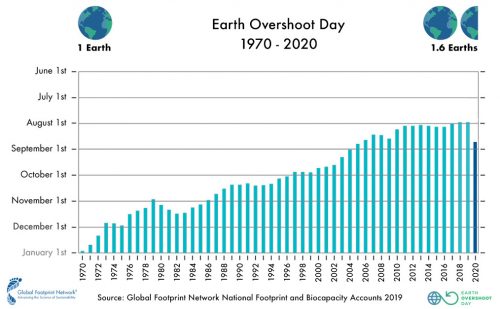Earth Overshoot Day marks the date when humanity’s demand for ecological resources and services in a given year exceeds what the Earth can regenerate in that year. This year, that day was August 22.
It’s an interesting date, because usually it gets earlier year by year, reflecting annual growing demand for resources and services. But this year, due to Covid-19, the date contracted back to August 22 from July 29 in 2019.
So, that tells us the pandemic has caused humanity’s ecological footprint to contract. But Overshoot Day argues; ‘True Sustainability That Allows All To Thrive On Earth Can Only Be Achieved By Design, Not Disaster.’
At BiU we know most low carbon firms would recognise the wisdom in that sentence; designing for sustainability has long been recognised as the better trodden path, as opposed to reactively veering towards it driven by events.
That being the case, what practical steps should firms be taking this year, as Overshoot Day shines a light on how our ecological impacts have taken a minor step backwards?

Virus driven improvements aren’t policy
Firstly, remember that all firms should be embedding sustainable and net zero planning deeply within their strategies. Covid may have diminished environmental impacts in the short term, but these have bounced back.
The Guardian has explained that carbon dioxide emissions have rebounded around the world as lockdown conditions have eased, raising fears that annual emissions of greenhouse gases could surge to higher than ever levels after the coronavirus pandemic, unless governments take swift action.
But businesses shouldn’t and indeed needn’t wait for government to lead. There are many ways to embed simple steps to reduce resource usage and carbon emissions today.
Among these, a focus on energy use and retrofit is a fine example which Overshoot Day highlights.
Retrofitting business for the better
Overshoot Day estimates that existing off-the-shelf, commercial technologies for business buildings, industrial processes and electricity production could move Overshoot Day at least 21 days for the better, without any loss in productivity or comfort.
Such solutions could work across many edifices; from offices to warehouses, from manufacturing to retail and beyond. They include elements like active energy efficiency systems, which can result in energy savings ranging from 22% in apartment buildings to 37% in three-star hotels, or 56% at primary schools.
These findings are compelling; they show how simple business choices can rapidly impact on the carbon bottom line. But that isn’t the only technology ripe for implementation.
Other technology can address intermittent occupancy levels (such as putting controls on idle mode when hotel rooms are unoccupied); use CO2 sensors to better control temperature and air quality; optimise heating by occupancy level; control ventilation with CO2 sensors and open and close blinds to leverage the sun for free natural light and heat, or indeed to keep heat out.
The point is, that business and humanity combined can indeed meet our carbon reduction needs if we take practical, decisive action.
Coronavirus has disrupted the business normal, but perhaps we should be doing so regardless.
Next year’s Overshoot Day
It will be truly intriguing to look back in a year’s time and discover what the longer term impacts of Covid-19 have been.
Will the world still be in reactive mode? Will governments both national and international have discovered a vaccine?
And if they have, will carbon emissions and business have returned to normal, and hence continued to grow? Or maybe, in a more fruitful scenario, the virus will be under control, but business will be growing while CO2 contracts, as sustainability becomes etched into the very fabric of society; no longer an outlier on the periphery.
The Organisation for Economic Co-operation and Development (OECD) writes: ‘As the health crisis abates, the question will be how to revive an ailing economy and to generate jobs, while avoiding locking in carbon-intensive infrastructure and capital assets that will undermine long-term climate objectives.’
It’s a challenging question, but one that collectively society and business must answer, fast.








